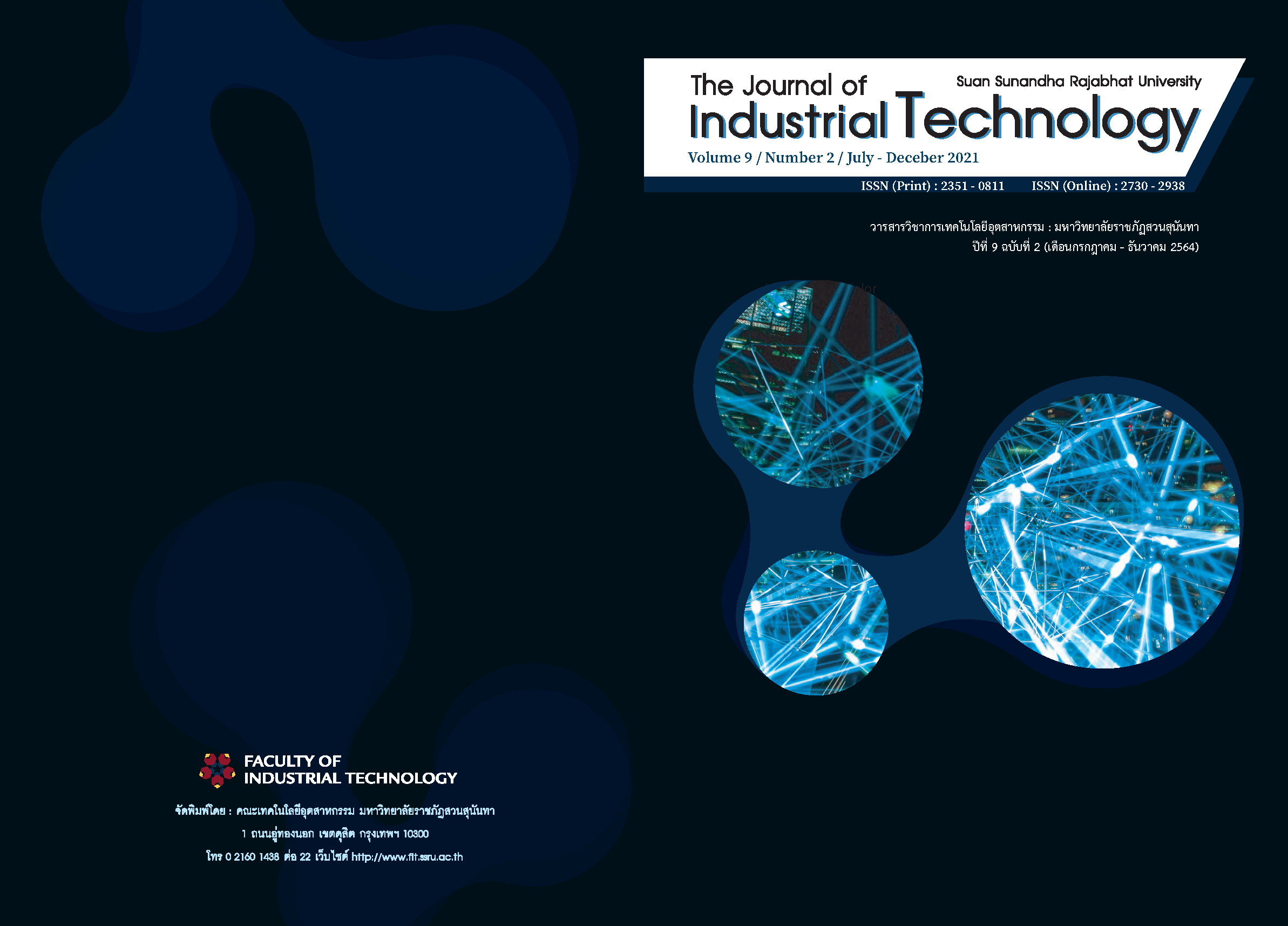สมรรถนะเชิงความร้อนของกระเบื้องคอนกรีตระบายอากาศที่ติดตั้งพัดลมไฟฟ้าเซลล์แสงอาทิตย์
คำสำคัญ:
กระเบื้องคอนกรีตระบายอากาศ, พัดลมไฟฟ้าเซลล์สงอาทิตย์, สมรรถนะเชิงความร้อน, จำนวนการเปลี่ยนอากาศ, ความร้อนรับบทคัดย่อ
บทความนี้ได้นำเสนอสมรรถนะเชิงความร้อนของกระเบื้องคอนกรีตระบายอากาศที่ติดตั้งพัดลมไฟฟ้าเซลล์แสงอาทิตย์ โดยกระเบื้องคอนกรีตระบายอากาศที่ติดตั้งพัดลมไฟฟ้าเซลล์แสงอาทิตย์ประกอบด้วยกระเบื้องคอนกรีตระบายอากาศ ท่อทางเดินอากาศเซลล์แสงอาทิตย์และพัดลม โดยที่พัดลมได้รับพลังงานไฟฟ้าโดยตรงจากเซลล์แสงอาทิตย์และไม่มีแบตเตอร์รี่ บ้านทดสอบจำนวน 2 หลัง แต่ละหลังมีปริมาตร 8 m3 บ้านทดสอบหลังหนึ่งมุงคอนกรีตปกติร่วมกับคอนกรีตระบายอากาศที่ติดตั้งพัดลมไฟฟ้าเซลล์แสงอาทิตย์โดยติดตั้งอยู่ทางทิศใต้ของหลังคา ในขณะที่บ้านอ้างอิงมุงหลังคาด้วยกระเบื้องคอนกรีตปกติเท่านั้น
สมรรถนะเชิงความร้อนของกระเบื้องคอนกรีตระบายอากาศที่ติดตั้งพัดลมไฟฟ้าเซลล์แสงอาทิตย์ แสดงในรูปความร้อนผ่านฝ้าเพดาน อุณหภูมิอากาศห้องใต้หลังคา อุณหภูมิห้องและจำนวนการเปลี่ยนอากาศ ผลการทดลองแสดงให้เห็นว่ากระเบื้องคอนกรีตระบายอากาศที่ติดตั้งพัดลมไฟฟ้าเซลล์แสงอาทิตย์สามารถสร้างจำนวนการเปลี่ยนอากาศภายในห้องทดสอบได้ในช่วง 6-7 ACH ทำให้อุณหภูมิห้องทดสอบมีค่าใกล้เคียงกับอุณหภูมิอากาศแวดล้อม นอกจากนี้บ้านทดสอบมีค่าความร้อนผ่านฝ้าเพดานต่ำกว่าบ้านทดสอบอ้างอิงโดยมีค่าเปอร์เซ็นต์การลดความร้อนสูงกว่า 40%
เอกสารอ้างอิง
S. Janjai, I. Masiri, S. Pattarapanitchai, and J. Laksanaboonsong, “Mapping global solar radiation from long-term satellite data in the tropic using an improved model,” International Journal of Photoenergy, Vol. 2013, ID: 210159, 2013.
J. Khedari, A. Sangprajak and J. Hirunlabh, “Thailand climatic zones,” Renewable Energy, Vol. 25,no. 2, pp. 267-280, February 2002.
J. Hirunlabh, W. Puangsombut, J. Waewsak and J. Khedari, “PV attic ventilation: a simple tool for reducing cooling load and providing comfort,” Interna-tional Journal of Ambient Energy, Vol. 23, no 3, pp. 159-168, Jul. 2002.
N. Nankongnab, W. Puangsom- but, S. Insiripong, J. Hirunlabh and U-C. Shin, “Field investigation on hygrothermal performance of full-vent perforated soffit and ceiling,” Solar Energy, Vol. 80, no. 80, pp. 936-948, August 2006.
W. Puangsombut, J. Hirunlabh, J. Khedari and U-C. Shin, “Field investigation on moisture reduction by perforated ceiling,” Sustainable Energy and Green Architecture (SEGA 2003), International Conference, Bangkok, 2003, pp. (GA213-219).
O. Amornleetrakul, W. Puang-sombut and J. Hirunlabh, “Field investigation of the small house with the ventilate roof tiles,” Advance Materials Research, Vols. 931-932, pp. 1233-1237, 2014.
K. Juengpimonyanon, W. Puang-sombut and T. Ananacha, “Field investigation on thermal performance of the tile ventilator,” Applied Mechanics and Materials, Vols. 619, pp. 73-77, 2014.
S. Phiraphat, R. Prommas and W. Puangsombut, “Experimen-tal study of natural convection in PV roof solar collector,” International Communications in Heat and Mass Transfer, Vol. 89,pp. 31-38, December 2017.
S. Phiraphat, R. Prommas, T. Tondee and W. Puangsombut, “Thermal performance of PV roof solar collector,” Sustainable Energy and Green Architecture (SEGA 2016), International Conference, Bangkok, 2016.
D. Nonthiworawong, “Design of a light-vent pipe (LVP) to reduce building cooling load”, Ph.D. Thesis (Sustainable Energy and Environment Technology and Management), Rajamangala University of Technology Rattanakosin, Nakhon Pathom, TH, 2017.
J. Khedari, C. Pongsatirat, W. Puangsombut and J. Hirunlabh, “Experimental performance of a partially-glazed Modified Trombe Wall,” International Journal of Ambient Energy, Vol. 26, no. 1, pp. 27-36, 2005.
W. Puangsombut, D. Nonthi- worawong and T. Lohapan- somboon, “Effect of moisture reduction on thermal comfort by solar chimney window with small ventilation fan,” The Journal of Industrial Technolo-gy, Vol. 8, no. 1, pp. 22-30, January-June 2020.
ดาวน์โหลด
เผยแพร่แล้ว
รูปแบบการอ้างอิง
ฉบับ
ประเภทบทความ
สัญญาอนุญาต
บทความที่ได้รับการตีพิมพ์เป็นลิขสิทธิ์ของคณะวิศวกรรมศาสตร์และเทคโนโลยีอุตสาหกรรม มหาวิทยาลัยราชภัฎสวนสุนันทา
ข้อความที่ปรากฏในบทความแต่ละเรื่องในวารสารวิชาการเล่มนี้เป็นความคิดเห็นส่วนตัวของผู้เขียนแต่ละท่านไม่เกี่ยวข้องกับมหาวิทยาลัยราชภัฎสวนสุนันทา และคณาจารย์ท่านอื่นๆในมหาวิทยาลัยฯ แต่อย่างใด ความรับผิดชอบองค์ประกอบทั้งหมดของบทความแต่ละเรื่องเป็นของผู้เขียนแต่ละท่าน หากมีความผิดพลาดใดๆ ผู้เขียนแต่ละท่านจะรับผิดชอบบทความของตนเองแต่ผู้เดียว








